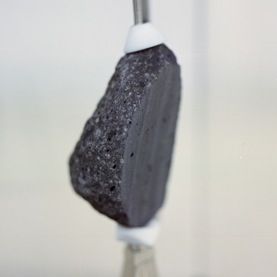
The moon of today is a static orb with little to no internal activity; for all intents and purposes it appears to be a dead, dusty pebble of a world. But billions of years ago the moon may have been a place of far more dynamism - literally.
A new study of a lunar rock scooped up by Neil Armstrong and Buzz Aldrin during their Apollo 11 mission indicates that the ancient moon long sustained a dynamo - a convecting fluid core, much like Earth'sthat produces a global magnetic field. The age of the rock implies that the lunar dynamo was still going some 3.7 billion years ago, about 800 million years after the moon's formation.
That is longer than would be expected if the lunar dynamo were powered primarily by the natural churning of a cooling molten interior, as is the case on Earth. The moon's small core should have cooled off rather quickly and put an end to any dynamo-generated magnetic field within a few hundred million years. So researchers may have to explore alternate explanations for how a dynamo could be sustained - explanations that depart from thinking of the lunar interior in terms of Earthly geophysics.
A standard-issue, Earth-like dynamo "would have died out on the moon much, much before 3.7 billion years ago," says Erin Shea, a graduate student in geology at the Massachusetts Institute of Technology and lead author on a study in the January 27 issue of Science. "We have to start thinking outside the box about what generates a lunar dynamo."
The first clues that the moon had a dynamo came from a number of lunar samples that appear to record the presence of a magnetic field at the time of their formation. Specifically, the magnetic field is locked in metallic particles in similar orientations. But some of that magnetism could be explained by short-lived magnetic fields rather than by a dynamo. A meteor impact, for instance, can shock a magnetic signature into nearby rocks.
So researchers investigating whether the moon had a more long-lived magnetic field look for evidence of lunar paleomagnetism encoded in rocks that formed slowly in the presence of that field. Such slow-cooling rocks would remain largely unaffected by transient magnetic fields that came and went during solidification. Shea and her colleagues based their study on a rock collected July 20, 1969, the day that humankind took its first "giant leap" onto the lunar surface. The sample is a basalt from volcanic flows early in lunar geologic history, and it would have taken about two weeks to cool - roughly 10 times as long as a short-lived magnetic field from an impact would be expected to persist.
Using a high-resolution magnetometer, the researchers found that the lunar sample indeed formed in the presence of a magnetic field, perhaps even one as strong as Earth's magnetic field today. "What this sample tells us is that at some point the moon did have a dynamo," Shea says. "This magnetic field lasted much longer than we had considered before."
A similar paleomagnetic study in 2009 by some of Shea's co-authors demonstrated the presence of a lunar dynamo some 4.2 billion years ago. That is just at the cusp of what would be possible with an Earth-like dynamo driven by a cooling interior alone. "Even then it's not trivial," says Ian Garrick-Bethell, a planetary scientist at the University of California, Santa Cruz (U.C.S.C.), who was the lead author of the 2009 study.
"It's nice because this sample is also very pristine, like the previous sample that I studied," Garrick-Bethell says. He notes that the new sample not only cooled slowly but also shows no evidence of having been shocked and reheated since its initial formation. "It's a high-quality recorder of magnetic fields," Garrick-Bethell says. "If this sample does have any remnant [magnetization] in it, combined with the pristine nature of the sample, it suggests that there really was a dynamo."
The evidence in favor of a dynamo has made enough believers that researchers are investigating what could drive a churning lunar interior over such long timescales. "It seems to me almost inescapable that there was a long-lived lunar dynamo," says U.C.S.C. planetary scientist Francis Nimmo.
He and his colleagues published a study in Nature late last year arguing that the gravitational pull of Earth could have tweaked the moon's spin axis enough to cause the solid outer layer and the fluid core to rotate differently. That could have stirred up the lunar interior to keep a dynamo churning until about 2.7 billion years ago. Another paper in the same journal noted that large impacts could also upset the moon's rotation enough to energize a dynamo. If that were the case, Nimmo notes, the dynamo's operation would have been somewhat intermittent. (Scientific American is part of Nature Publishing Group.)
The new study seems to imply that some such mechanism existed. "There is certainly a difficulty driving a conventional dynamo at 3.7 billion years ago," Nimmo says. "Some more exotic explanation - like orbital forcing or impacts - appears to be required."



Comment: Considering how pockmarked the far side of the moon is, it's interesting that the idea of cometary or meteor impacts is one that is apparently only reluctantly entertained. For more information on this topic see the articles in the left sidebar under "Comets and Catastrophes".